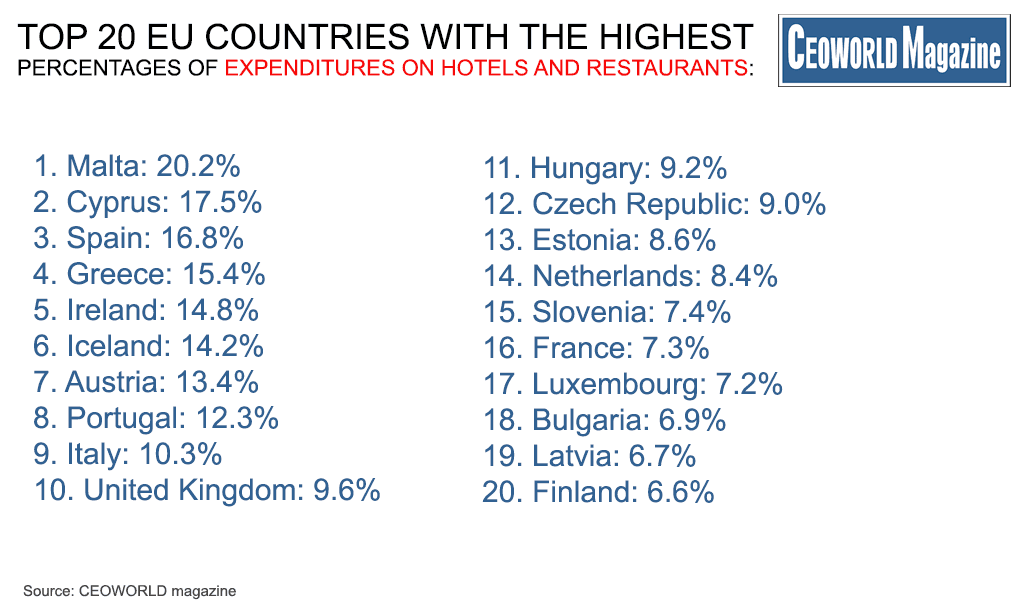How Much The Typical European Household Spends On Hotels And Restaurants?

Malta and Cyprus were the top two European Union member states with the highest expenditure for hotels and restaurants in 2017, according to the 2017 Eurostat study. An average of 16.8% of the household income of Maltese nationals is spent on restaurants and hotels.
Spain ranked third, with 16.8% per household, behind Cyprus, whose residents spent a whopping 17.5% of their 2017 household income at hotels and restaurants. An average of 15.4% of the household income of Greeks is spent on hotels and restaurants.
Households in the European Union member states spent an average of 8.8% of their total consumption expenditure on hotels and restaurants in 2017, meaning that more than $847 billion were spent across the EU. This amount represents 4.8% of the EU’s GDP, $1,603 per E.U. inhabitant.
Countries with the lowest percentages of expenditures on hotels and restaurants were eastern and northern EU member states such as Romania, Poland, Lithuania, Lithuania, Germany, Denmark, and Slovakia.
EU countries with the highest percentages of expenditures on hotels and restaurants:
- Malta: 20.2%
- Cyprus: 17.5%
- Spain: 16.8%
- Greece: 15.4%
- Ireland: 14.8%
- Iceland: 14.2%
- Austria: 13.4%
- Portugal: 12.3%
- Italy: 10.3%
- United Kingdom: 9.6%
- Hungary: 9.2%
- Czech Republic: 9.0%
- Estonia: 8.6%
- Netherlands: 8.4%
- Slovenia: 7.4%
- France: 7.3%
- Luxembourg: 7.2%
- Bulgaria: 6.9%
- Latvia: 6.7%
- Finland: 6.6%
- Belgium: 6.5%
- Sweden: 6.5%
- Slovakia: 6.2%
- Denmark: 6.1%
- Germany: 5.5%
- Lithuania: 3.7%
- Poland: 3.6%
- Romania: 3.1%
European Union: 8.8%
Add CEOWORLD magazine to your Google News feed.
Follow CEOWORLD magazine headlines on: Google News, LinkedIn, Twitter, and Facebook.
This report/news/ranking/statistics has been prepared only for general guidance on matters of interest and does not constitute professional advice. You should not act upon the information contained in this publication without obtaining specific professional advice. No representation or warranty (express or implied) is given as to the accuracy or completeness of the information contained in this publication, and, to the extent permitted by law, CEOWORLD magazine does not accept or assume any liability, responsibility or duty of care for any consequences of you or anyone else acting, or refraining to act, in reliance on the information contained in this publication or for any decision based on it.
Copyright 2024 The CEOWORLD magazine. All rights reserved. This material (and any extract from it) must not be copied, redistributed or placed on any website, without CEOWORLD magazine' prior written consent. For media queries, please contact: info@ceoworld.biz
SUBSCRIBE NEWSLETTER










